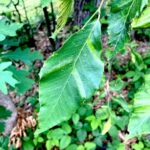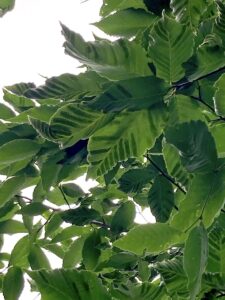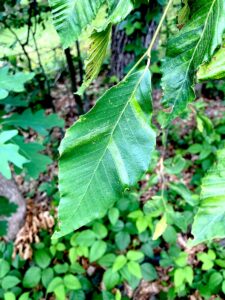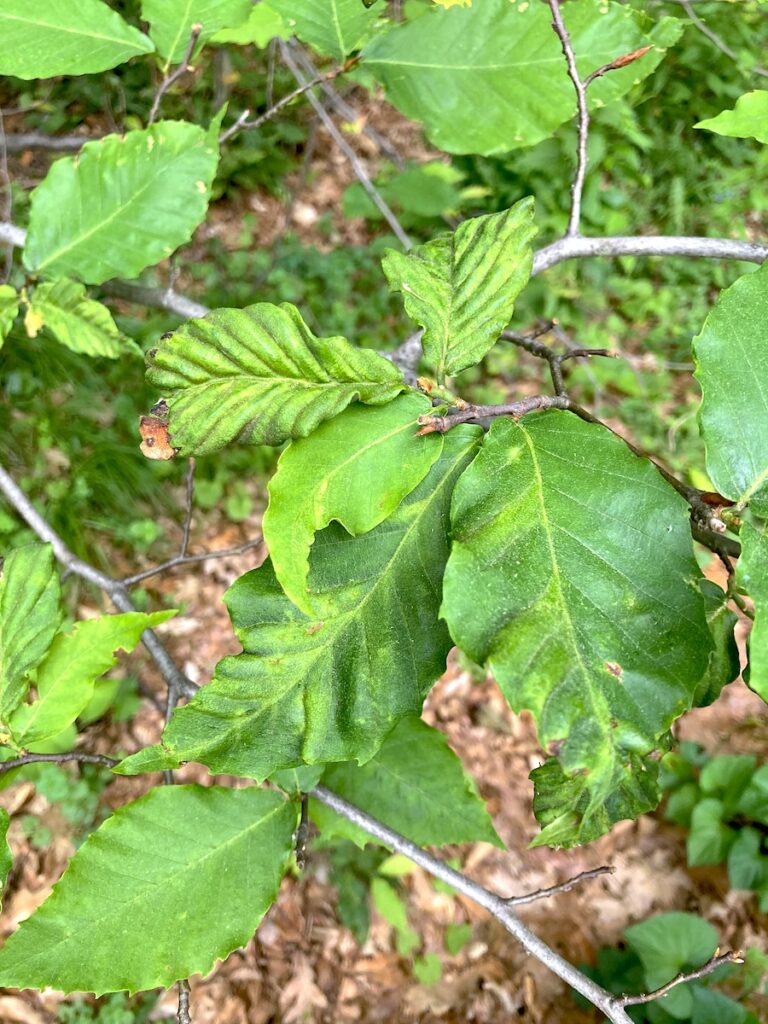
By Phil Perron
The majestic beech tree is under attack in Massachusetts. The culprit is a microscopic nematode (Litylenchus crenatae ssp. mccannii). Beech leaf disease (BLD) has taken the state by storm, causing, in the best cases, leaf distortion and, in the worst cases, total tree mortality. All beech tree varieties are at risk, including the stately copper beech. Unfortunately, many questions about this disease have yet to be answered as the industry works to find solutions to manage this pest before it is too late.
BLD was first discovered in Ohio in 2012. Eight years later, it had made its way to Connecticut, and as of this writing, it has been reported in most counties across Massachusetts. While nematode damage to plant material is not unheard of, the destructive nature and tree loss associated with this pest are concerning.
BLD damage is relatively easy to see and diagnose when the trees have leaves on them. Looking up through the canopy on a sunny day, you will see dark green patches in the leaves between the leaf veins. This is pretty pronounced on green-leaved beech trees like American beech with dark green bands contrasting with a lighter leaf color.
Red leaved beech trees, like copper beeches, hide the damage a little better. However, you will see the same banding though it will be redder in color, blending in with the darker leaves.
During a heavy infestation, the leaves take on a leathery appearance, and the trees will look sparse and thin. Given enough damage, some trees will drop damaged leaves and push a new set of leaves. The new leaves will not be infected with BLD at emergence but are often light in color and weak. Reserved energy is required to push this second set of leaves, putting further stress on the tree.
Management decisions should begin with an understanding of the lifecycle of the pest. The microscopic nematode spends the fall, winter, and early spring months in the buds of beech trees, feeding and destroying leaf tissue while laying eggs. As the leaves emerge in the spring, we see damage on the newly emerged leaves caused by the nematodes. In some cases, damage to the leaves in the buds will be so severe that the leaves will not emerge. These dead buds will be loaded with eggs that are still viable.
While there is some debate on movement, it is thought that the eggs and hatched nematodes are moved around by birds, wind, and water. Once hatching has occurred, the nematodes will enter next year’s buds in August, and the cycle continues.
Studies are ongoing on the effects that the damage can have on trees over time, because of the resulting mortality and tree loss. Beech trees are a major player in the forests of the Northeast. We see BLD deep in our forests, causing decline and outright death. We also see other insects and diseases moving in on stressed trees with BLD infestations. There has been a correlation with increased anthracnose infections on trees and BLD.
So, what can be done? Is it all doom and gloom? Science is playing catch up. I would love to tell you that we have a proven solution. The reality is this: the nematodes spend a lot of time protected in the buds of the trees. They are doing damage at this time and contacting them is difficult once they have entered the buds. The products we can use are limited in their efficacy and are in very limited supply. Treating large beech trees with foliar products can be very challenging. There is also some uncertainty on the timing of applications, and we are concerned with resistance development in the products we can use.
Now, the good news. There is promising research on the use of phosphite products applied directly to the tree or injected into the soil.
Everyone is starting to take notice of this issue. The urgency of the situation has caught the attention of many in the industry. There is a lot of ongoing research regarding this pest, and I suspect that recommendations will be ever-changing. The most encouraging news is that we do have treatment options, and while limited, they can be employed.
We have been in situations like this before. Think about the American elm (Dutch elm disease) and the American chestnut trees (chestnut tree blight). Although not total success stories, eventually, science catches up, treatments are developed, or other strategies are employed. We lost many elm trees before a treatment method was adopted with success. The American chestnut has seen some positive results, with resistant varieties being planted in recent years.
The best advice I can offer at this time is if you have a beech tree on your property, please consult with a certified arborist. The Massachusetts Arborists Association (massarbor.org) lists certified arborists. These credentialed professionals will be able to give you an honest assessment of your tree with the most current advice and recommendations available.
Phil Perron is the plant health care director at Barrett Tree East in Medford, Massachusetts. He is a Mass Certified Arborist and an ISA Certified Arborist. He has been in the green industry for the past 23 years.





Sorry, the comment form is closed at this time.